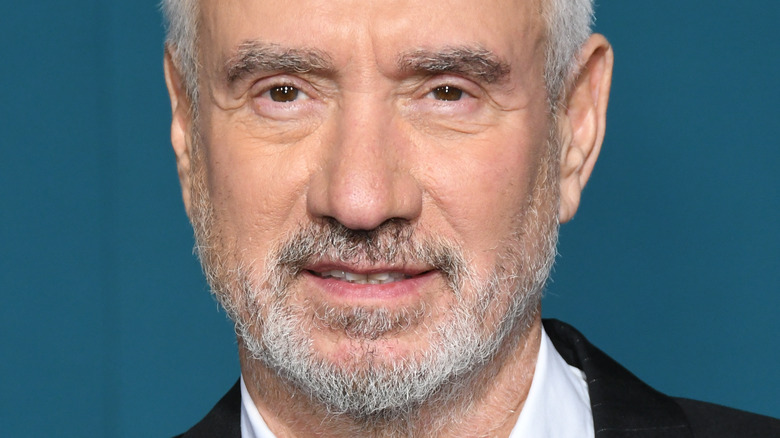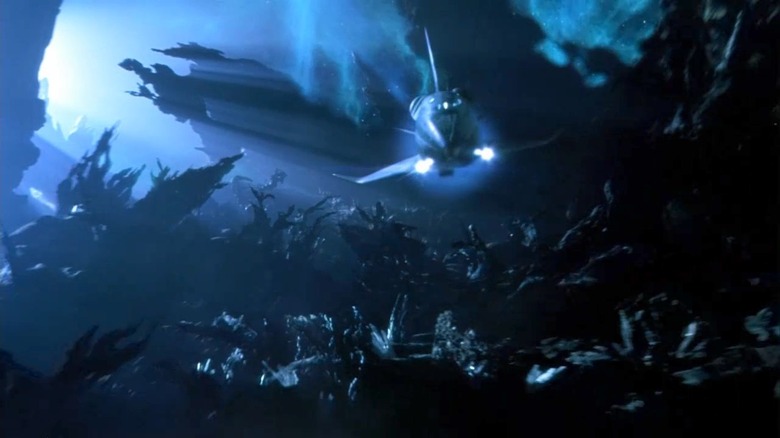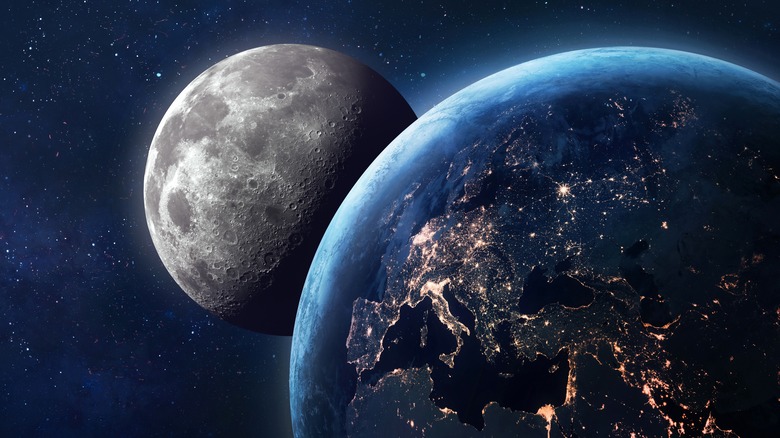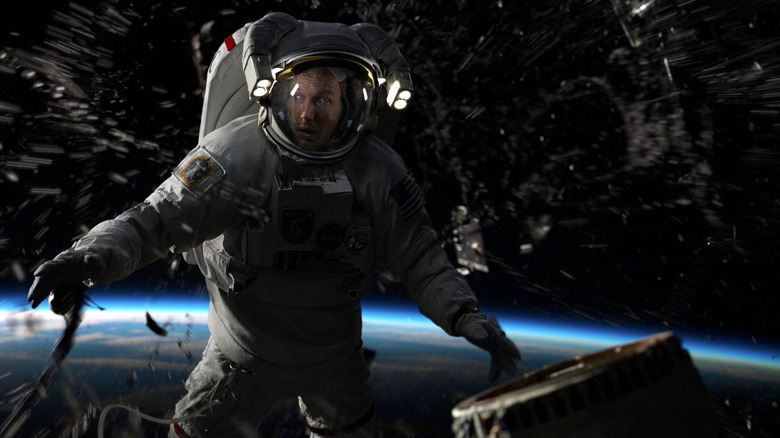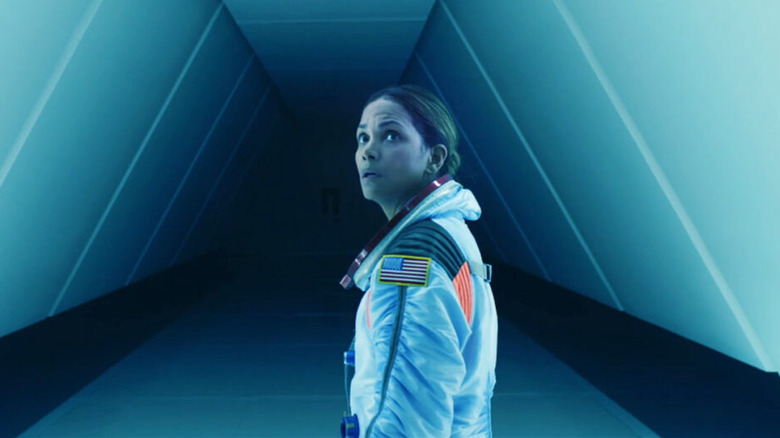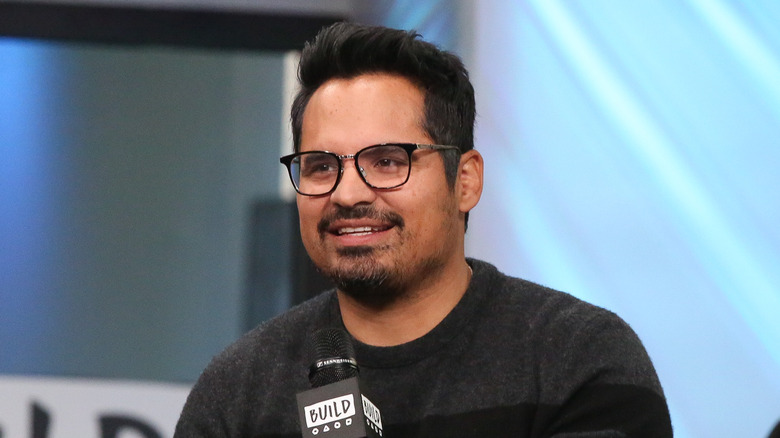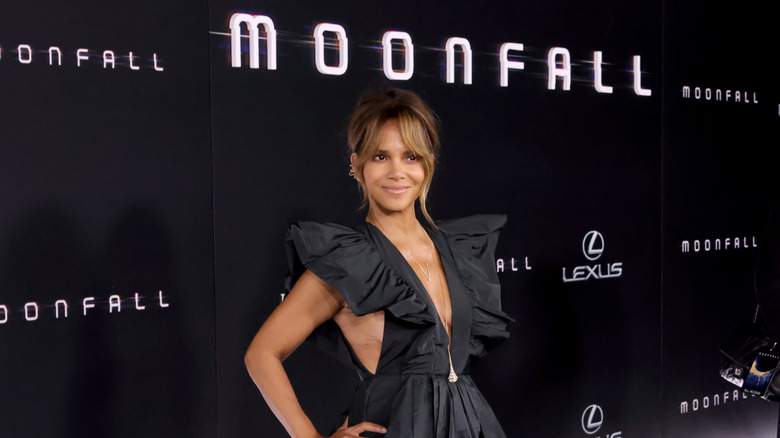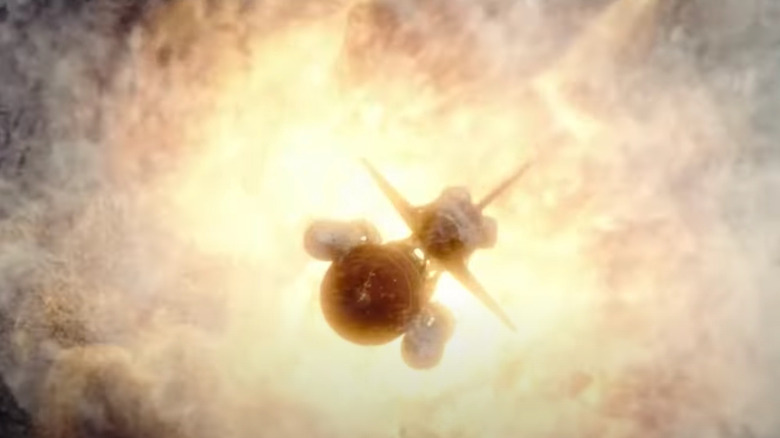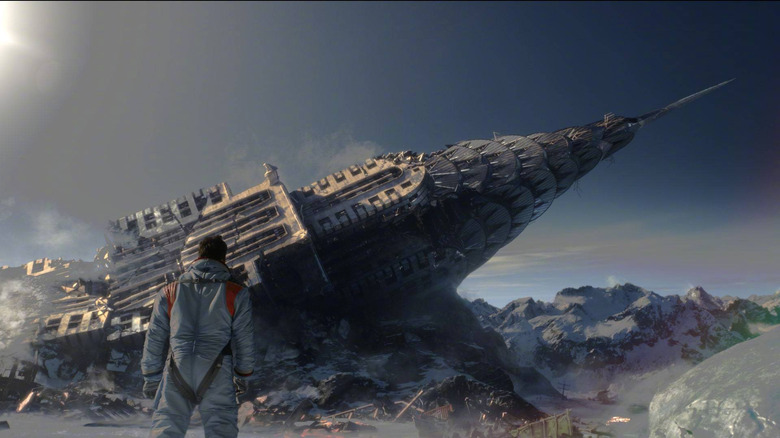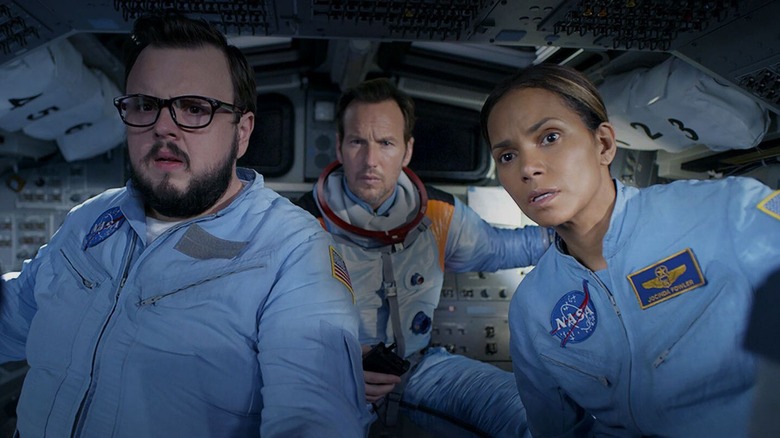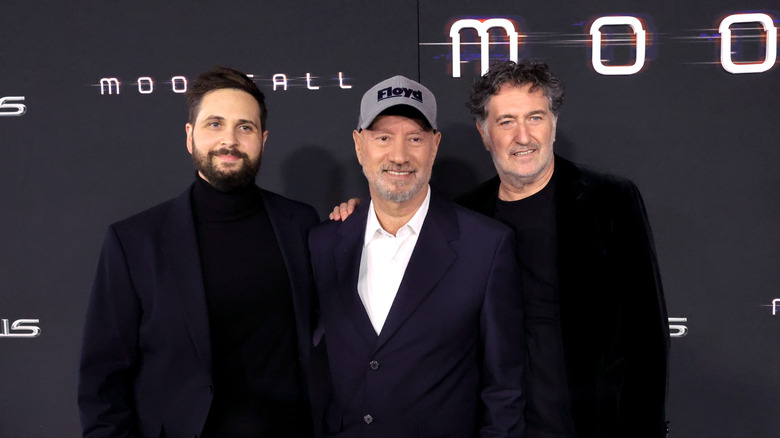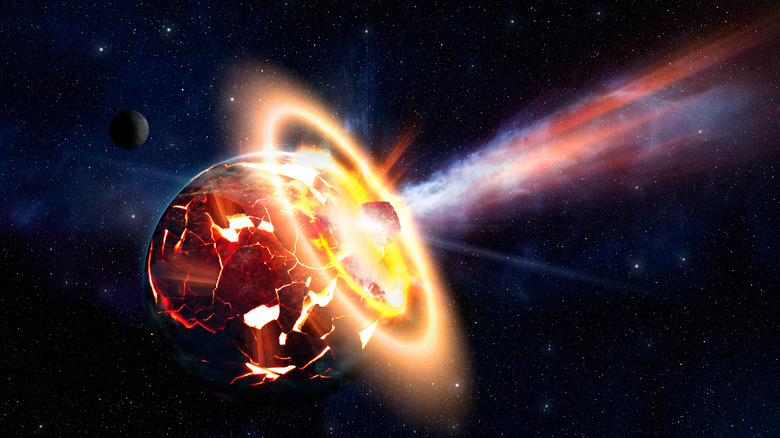Moonfall Facts That Are Anything But Disastrous
When it comes to event films in the movie industry that cost over $100 million to make, most are produced through one of the major studios and the flicks are often tied to a popular IP (intellectual property) with a well-established fan base. However, that is not always the case. With enough experience, clout, and vision, some exceptional individuals are able to pull it off nearly all on their own. With "Moonfall," director, producer, and co-writer Roland Emmerich proved that he is one of those people.
In addition to Emmerich and his talented team behind the camera, "Moonfall” stars several veteran actors like Halle Berry, Patrick Wilson, and Michael Pena. But that is not what sets it apart from other disaster films. What does make the movie unique is an intriguing, alien twist to what may seem like a common premise, and with the Moon as Earth's possible destroyer, the scale is more colossal than an average asteroid impact. Completing the project was a massive undertaking as well, which becomes all the more clear from the behind-the-scenes stories that follow.
Roland Emmerich wanted to make an asteroid film for decades
Before Hollywood decided that 1998 would be the year of space rock disaster flicks, with the release of both "Armageddon" and "Deep Impact," filmmaker Roland Emmerich was also planning on making a film with a similar premise right after finishing "Independence Day." He told The Hollywood Reporter, "I was constantly working on my meteor film. It just got swept away by 'Godzilla,' and then all of a sudden, Michael Bay came along and did it first."
Emmerich was honest about why he was convinced to put his own project on hold, which boiled down to the fact that he was presented with such a good offer to direct "Godzilla" that he simply could not refuse it. But even so, the filmmaker secretly hoped he would be replaced as the director when he demanded that the giant monster look more like a lizard than its traditional appearance with its characteristic bulging belly. Yet when Toho, the studio that created Godzilla, said it was fine to have a Hollywood version of the creature, Emmerich knew he could not get out of it. It took almost 25 years for him to finally make his own action epic about a gigantic celestial body colliding with the Earth, "Moonfall."
Who Built the Moon? inspired the film
Literature is often a source of inspiration for Hollywood films and "Moonfall" is a prime example. After Roland Emmerich read "Who Built the Moon?" by Christopher Knight and Alan Butler, he became fascinated with the controversial theory proposed in the book that the Moon was constructed by some unknown entity and then purposefully placed in an ideal position to help life on Earth flourish.
Most importantly for the filmmaker, the idea of an artificial Moon added an interesting twist to an asteroid collision story he had been thinking about for years. Even better was that the premise sent him down a creative path leading to not just one film, but enough material for a series. Emmerich told VFX Voice, "If you only do a story about the Moon falling down to Earth, that is a disaster movie. We wanted to do something deeper and more exciting than that."
Moonfall is one of the most expensive independent films ever
"Moonfall" was a pet project that Roland Emmerich had been developing for decades, so when he finally got the opportunity to make the film a reality, it was vital for him to retain as much creative control as possible. But to do so, and still gain the huge funds necessary to finance such a project, was quite an undertaking because it meant avoiding major studios with their access to large sums of money.
To accomplish his goal and find eager investors, Emmerich went to one of the most renowned film events in the world, the Cannes Film Festival. He told The Hollywood Reporter how it all went down, explaining, "These kinds of movies never get offered in Cannes. It's a tall task. Scanline [VFX] helped us do this one-shot trailer, which was really cool. We had no cast, so then Harald [Kloser, producer and co-writer] and I kind of sat on these two chairs [and took questions] in front of all the buyers." He added, "This was a full room, trust me."
The plan worked and Emmerich managed to raise $140 million, which is especially rare for an independent film on the scale of "Moonfall," according to Deadline. Without a major studio involved, the filmmaker got what he wanted and was able to keep a 50% stake in the project.
COVID almost ended the film in pre-production
COVID affected all major Hollywood projects and "Moonfall" was among those that were forced to put its production on hold. But since the film was an independent project, the delay was particularly difficult for filmmaker Roland Emmerich to deal with just seven weeks before the shoot was scheduled to start. He admitted to Deadline, "It was a miracle this movie happened at all. We got it done but it took a lot longer than I thought it would." To explain the chaos of the situation, he said, "We were plain sailing at the start of last year but then we had to immediately shut down due to the pandemic. There was a lot of back and forth between insurance companies and banks."
By the time the project could finally move forward, an extra $6 million was added to an already enormous budget. With the added costs, sacrifices had to be made, which meant that Emmerich had to cut down the number of days that he could film from the planned 74 to 61 instead. Yet as he explained to VFX Voice, the filmmaker simply had no choice but to speed up his filming.
135 sets were used during production
Creating an epic film on the scale of "Moonfall" is already a gargantuan task for a production designer, but Kirk Petruccelli had an even more difficult job due to changes that needed to be made because of COVID restrictions. All in all, 135 sets were constructed on six main stages at Grandé Studios in Montreal, Canada, with some spilling over to a few more stages at MELS Studios. So many sets were required because the crew ran into too many issues trying to film at real locations in Colorado and Los Angeles. All of the construction was further complicated by the fact that everything had to adhere to the pandemic protocols and encourage social distancing.
The extensive collection of sets was certainly put to good use quite effectively, with four to five serving their purpose during every day of filming. Petruccelli explained to VFX Voice, "Every set was specifically crafted with the visual effects team in mind. Roland thinks far beyond the physical structure. It all has to integrate with the post-production process. He is masterful at that. We had to come in and know when we could use one section of the stage, move it to another section, and rotate pieces of it away to create another set."
There was some shakeup in the cast
Once the chaos of the initial pandemic lockdown was over, filming for "Moonfall" was allowed to proceed, yet COVID continued to cause difficulties for the production. The new travel restrictions, in particular, turned out to be disastrous for one cast member, Stanley Tucci, who ultimately could not appear in the film because he had to fly from the U.K. to Canada.
Producer Harald Kloser described the tough situation to Deadline, saying that Tucci would have to immediately go into quarantine for two weeks after arriving in the country, which would in turn create scheduling issues for the production. "We were very disappointed," he explained. "But it was high-fives all round when we heard Michael Pena could step in. He brought a great angle."
The issues continued, however, as it was discovered that Pena's passport was expired. But it all worked out for the actor after he strategically entered the northern country through a border checkpoint that only required a birth certificate. For one final cast member, the situation also looked bleak for a time, but was ultimately resolved as well. Roland Emmerich revealed to The Hollywood Reporter that he initially wanted "Game of Thrones" star John Bradley for the role of K.C. Houseman, and the actor confirmed that he was fully on board. The studio then convinced the filmmaker to go with Josh Gad instead, but when a scheduling conflict arose for Gad, Bradley was delighted again to take on the part.
Halle Berry had prior experience playing an astronaut
For much of "Moonfall," the lead stars appear in scenes that take place in the fascinating, yet harsh, environment of outer space. To simulate operating in such strange conditions, knowledge of what the experience is truly like certainly comes in handy, as it did for Halle Berry going into the project. No, she did not ever actually leave the planet at any point, but she previously played an astronaut and did a respectable amount of preparation for that role.
In the TV series "Extant," which premiered in 2014, Berry's character spent months in space. Berry not only took time to prepare physically, but also learned about living in that environment from several expert sources. When talking with Cinemark, the actress said, "I did a lot of training. I took a zero-G flight, talked to astronauts, young and old, ones that were still in the field, [both] men and women, [took] trips to NASA. So, I had done a lot of research for that television show, and I got to just, you know, revisit all of those things that I learned five years ago."
NASA supported the production
"Moonfall" is clearly a science fiction film, but a considerable amount of effort was put into the project to make it as accurate as possible. A significant part of the filmmakers' plan to incorporate real aspects of spaceflight was in securing the support of NASA for consultation. Roland Emmerich told VFX Voice that with the extraplanetary experts reviewing the script, the writers were careful to get everything right even though the process took three to four years to complete.
On top of the direct guidance from the space organization, several consultants were also brought on board during production. The team consisted of a medical professional, an astronaut, and a physical consultant, along with three more who focused in science, such as geophysicist Mika McKinnon. McKinnon described what it was like to work on the film in an interview with Space, saying, "I got to talk about things like the Apollo missions, when we started deliberately banging things into the moon in order to do deep geophysics." She clearly was pleased with the results, adding, "There's a lot of really, like, actually good science muzzled in all over the place in this movie, everything from, like, the horizon glow of what it looks like to look at a sunrise, sunset and space."
The film combines CGI effects with massive set pieces
Filming a movie like "Moonfall" was a difficult process because the CGI effects were generated simultaneously with the physical shoots on set, so every detail had to be carefully planned in advance. As Roland Emmerich explained to VFX Voice, the preparation was rather extensive since the film contained 1,700 visual effects shots. To pull off such a huge number of computer-animated moments for the flick, visual effects supervisor Peter Travers worked closely with a few Montreal-based companies, such as Scanline VFX, DNEG, Framestore, and Pixomondo.
To complement the CGI, the crew also built huge set pieces as well. The largest was a 45-foot-tall rig with two tanks containing 3,200 gallons of water. Once set in motion, the massive machine created a wall of water to flood a hotel lobby.
While the impressive construction produced great practical effects, the conditions during the filming of those real scenes were quite uncomfortable, according to John Bradley. The actor told Gizmodo that he came to the set thinking that Roland Emmerich had found a way to visualize all the water necessary for the scene through CG. But Bradley was in for a surprise instead, saying, "Then I got [to the set], and it was just gallons and gallons of water being squirted down a huge ramp right into my face, over and over again. I swallowed an ungodly amount of it."
Filming in the shuttle cockpit was more intimate
Much of the story of "Moonfall" takes place in grand landscapes on a massive scale throughout the film. On the other hand, the perspective of the lead stars was the exact opposite for a good portion of the production, as many of their key scenes happened in a very different environment. In his interview with Gizmodo, John Bradley described what it was like for the trio to film inside the very tiny shuttle cockpit set, saying, "The shuttle cockpit was a very, very, very, very closed space and myself and Halle and Patrick were in there for weeks on end. That became a very intimate acting experience, actually, and it was more about the chemistry that we created between the three of us."
Bradley went on to comment that while the special effects may awe audiences for the visual spectacle that they provide, the personal scenes showing the interactions of the characters were far more important to him as an actor. They are also vital scenes for the viewers to see, as those human moments draw them deeper into the story on an emotional level.
The filmmakers were open for sequels
Like most current filmmakers, Roland Emmerich and producer Harald Kloser both wanted "Moonfall" to be the first of several films. Kloser's eagerness for the idea was clear in his interview with Deadline when he added at the end of the conversation, "Don't forget that 'Moonfall' is written as the beginning of a saga. It opens the door onto an epic adventure."
Similarly, Emmerich briefly discussed with The Hollywood Reporter about how he normally does not produce sequels, but he would be willing to make an exception in this case. He said, "If it's an enormous, enormous success, why not? What I will then do, is do two and three together. And have a real, clear cliffhanger [in between]." Yet given how poorly the film performed at the box office, the duo are now probably far less excited at the prospect of working on the project — and even less enthusiastic about the prospect of raising the money for it.
Moonfall is one of the biggest box office flops of all time
"Moonfall" was already an incredibly ambitious project to begin with as an independent movie, but ongoing fears about sitting in public theaters, brought about by the pandemic, only made the situation so much worse for a film that was not released on any streaming services. There was so much going against the film that it may seem as if it was destined to fail, which it did in a major way. While "Moonfall" took $140 million to make, it only brought in $10 million at the box office for its opening weekend in February 2022, as reported by Deadline. Its total worldwide gross was a little over $59 million, meaning that the film lost somewhere in the range of $110-$140 million.
In the end, "Moonfall" is another example of how not all gambles pay off in Hollywood, and that it's possible for any investment to lose a considerable amount of money even when the production is backed by veteran filmmakers and a star-studded cast. Also, saturation is a thing, and no matter how epic and unique a movie may seem, another effects-heavy sci-fi or disaster flick is just one of a multitude released these days.
